There are several forces that effect air parcels in an air mass. These forces are what cause the wind to blow in the first place and will have some affect on wind speed and direction. They also affect the heights of the air mass in a region and will even affect the rotation of a pressure system which can change the out come of the weather associated with that system.
It is important to understand these forces as they are applies to the atmosphere, they will cause a thunderstorm to collapse or a hurricane to shear apart. You may have seen a cloud just disappear before your eyes. That is the effect of atmospheric forces.
This article covers will go into depth on the forces of the atmosphere and give you a basic understanding of the constant seeking for a balance the atmosphere we live in strives for.
GRADIENT FORCES
Pressure Gradient Force (PGF)
Pressure Gradient Force (PGF) is a force acting on a parcel of air, resulting from the difference in pressure on either side of the parcel.
This pressure difference is what causes the wind to blow. Wind always blows from high pressure toward low pressure. In the winter when you have the heat on and your house is 70°F an it is 30°F outside, the cold air is heavier than warm air and when you open the door that cold wind always blown into the house. It is the opposite in the summer.
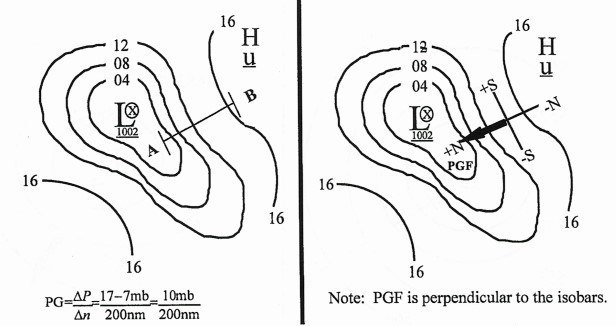
Pressure Gradient (PG=ΔP/Δn), is the rate of pressure change (ΔP) with distance (Δn). On a weather chart, it is always measured perpendicular to the isobars. Along the “n” axis in the natural coordinate system.
Changes in pressure result from a change in the quantity of mass over a given point. This may be the result of the actual removal/addition of mass or a change in the density of the atmosphere by differential heating/cooling. Pressure gradient force is directly proportional to the strength of the pressure gradient. If the pressure gradient increases, then the pressure gradient force increases. If the pressure gradient decreases then the pressure gradient force will also decrease.

The negative sign in the equation shows that the pressure gradient force, a vector, is always directed towards lower pressure, perpendicular to the isobars. This force will act to move air parcels towards lower pressures which initiates the wind.
Contour Gradient Force
Contour gradient force (CGF) is the force that represents PGF on a constant pressure chart.
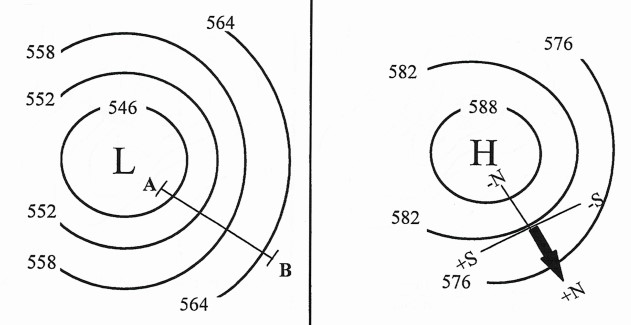
Contour gradient (CG = Δz/ Δn), the rate of height change with change in distance on a constant pressure surface. Much like hills and valleys on the earth’s surface correspond to the higher and lower height values, respectively, on a constant pressure surface. Differences in virtual temperature and the quantity of mass over a given point in the atmosphere results in changes in thickness between layers. These variations in height result in the contour gradient.
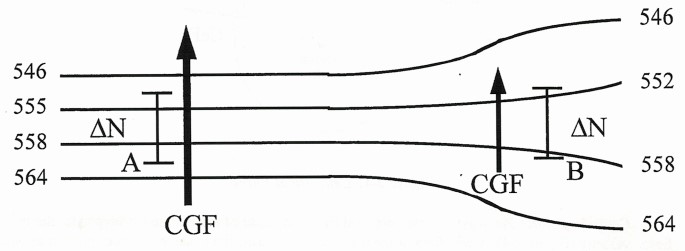
Contour gradient force is directly proportional to the strength of the contour gradient. If the contour gradient increases then the contour gradient force must also increase. Conversely, if the contour gradient decreased then the contour gradient will decrease.

The negative sign shows that contour gradient force, a vector, is always directed toward lower heights, perpendicular to the contours. This force will act to move air parcels toward lower heights which initiates the wind.
Rotational Forces
Centrifugal Force
Centrifugal force (CeF) is an apparent force that deflects particles, and therefore winds, away from the center of rotation. It’s the apparent force which pushes you to the outside of the turn as your car goes around a curve. As a kid if you have ever put water in a bucket and spun it around in circles, you have used centrifugal force to keep the water in the bucket.

Centrifugal force (CeF) is always directed outward from the center of rotation and is perpendicular to linear velocity. Centrifugal force is needed to describe the balance of forces present as wind flows around highs, lows, ridges, troughs, or anytime the flow is not in a straight line. The strength of centrifugal force is dependent on two factors. First, the greater the velocity of the moving parcel, the greater the centrifugal force for a constant curvature. Secondly, as the radius of curvature decreases with velocity constant, centrifugal force increases.
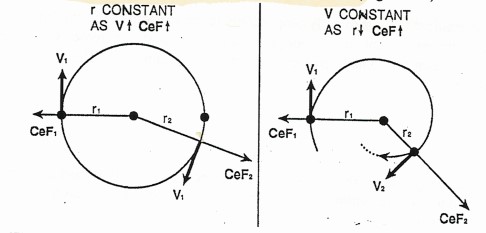
Coriolis Force
Coriolis force (CoF) is an apparent force exerted on moving objects caused by the rotation of the earth and its coordinate system. It is equal to the product of the coriolis parameter (f) and the linear velocity (v).
This one is quite often argued as a fictional force that has no direct effect on an object in the atmosphere. If you have ever shot a rifle more than 1000 yards, you have probably experienced something that effected the round down range.
CoF=fv
Coriolis parameter is equal to 2 Ω sin(θ), where Ω is the earth’s angular velocity, a constant, and sin(θ), is the latitude. Since the sine of 0° latitude = 0 and the sine of 90° = 1, therefore, coriolis force is zero at the equator and increases as you move poleward. Coriolis force is also dependent on velocity. If the coriolis parameter (f) is constant (for a constant latitude) and CoF = fv, then as the velocity increases, coriolis force also increases. The coriolis force measures the effect of the rotation of the Earth and it’s coordinate system relative to a moving object in the atmosphere.

То an observer on a star in space (considered a fixed location relative to the rotating Earth) an air parcel moves in a straight line when other forces acting upon the parcel are in balance.
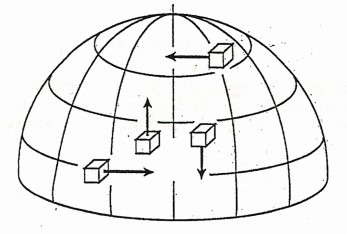
To an observer on the GOES satellite which rotates with the Earth’s coordinate system, (latitude/longitude), or to an observer on the Earth, air parcels are “deflected” to the right of motion in the northern hemisphere and to the left of motion in the southern hemisphere.
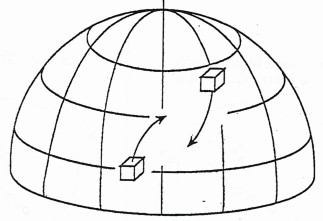
Coriolis force always acts 90° to the wind direction, when using the natural coordinate system, the coriolis force is in the -n direction in the northern hemisphere, and the +n direction in the southern hemisphere. The closer you get to the poles, the stronger the coriolis force if wind speed remains unchanged. As velocity decreases, coriolis force and centrifugal force decrease because they are dependent upon velocity. The weaker the velocity for a constant curvature the weaker the centrifugal force. If latitude, and therefore coriolis parameter (f), is constant, then as velocity decreases coriolis force must decrease.
Frictional Forces
Frictional forces oppose motion and slows down everything that moves on the earth’s surface. Friction always acts opposite to the direction of motion. With an increase in friction, the wind velocity will decrease. However, friction has no direct effect on pressure gradient or contour gradient forces.
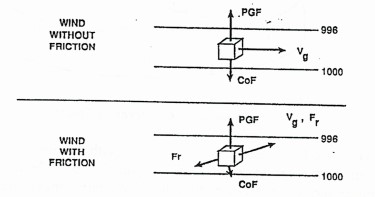
It will cause both coriolis and centrifugal forces to decrease. Winds will tend to back (a counterclockwise change of direction, backing-up on a clock) toward the stronger force.
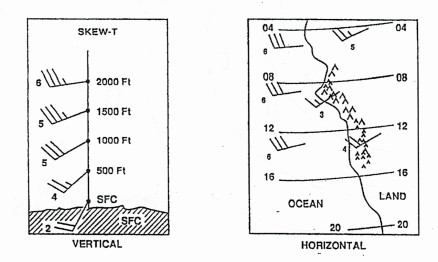
Recent Posts
Determining Severe Weather Based On Stability Indexes and Upper-Level Winds
There are several weather products used to determine the possibility of severe weather for an area. The most common and misunderstood by many weather enthusiasts is the Skew-T chart and the upper-air...
Tornado Basics, Severe Weather Preparation, & The Enhanced Fujita scale
Earth's weather can produce various kinds of windstorms which include waterspouts, dust devils and tornadoes. Although they have the common features of a column of rotating air, they are actually...

